Product Review: Svbony SV410 9-27 x 56mm ED Mini Spotting Scope

Product Review: Svbony SV410 9-27 x 56mm ED Mini Spotting Scope
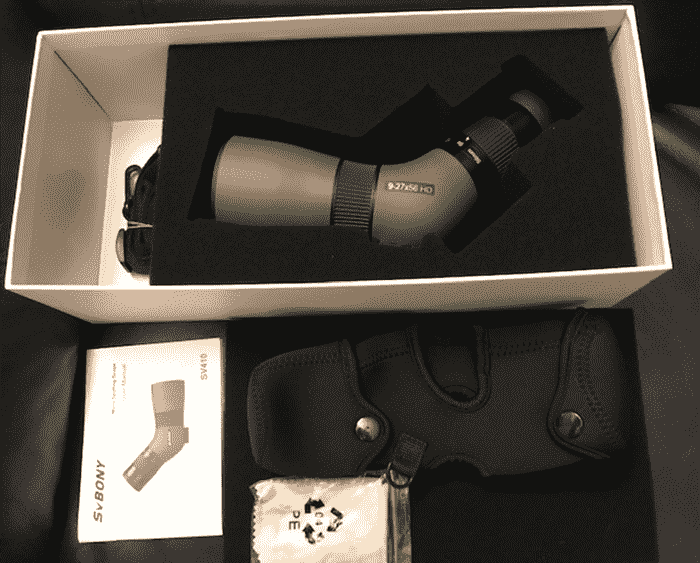
The Svbony SV 410 9-27 x 56mm ED Spotting Scope Package
Svbony is a relatively new Hong Kong-based optics firm that began supplying amateur astronomers and nature enthusiasts with a wide range of cost-effective but good-quality instruments and accessories in 2014. A google search of Svbony products will reveal a large and international fan base of customers who have been pleased with their eyepieces, filters, night vision devices, and more recently, the company’s extensive range of astronomical and terrestrial spotting scopes.
My introduction to Svbony came as a result of testing out a trio of high-performance binoculars from their SV 202 range. What astonished me most about these binoculars was their excellent optical and mechanical performance at prices that were simply unbeatable in today’s market. These experiences collectively whetted my appetite to explore some more of their products, and in this review, I will be sharing my thoughts on their newly launched mini-spotting scope that combines weatherproof ruggedness with good optical performance, in an ultra-portable package; enter the SV 410 9-27 x 56mm ED spotter, which first appeared on the market back in April of this year.
The scope was purchased from Amazon UK for a price of £179.99 and arrived a couple of days after ordering. Readers may also purchase the instrument directly from Svbony via this link, which will allow you to purchase the scope more cheaply if you can tolerate a longer shipping time(usually about 8 days)The instrument came well packed inside a long, white box with the blue and yellow Svbony logo, and with all of its accessories neatly packed inside. The little spotting scope was carefully placed inside a snugly fitting black foam bed, carefully cut to match the angled shape of the instrument. The accessories included a comprehensive multi-language instruction manual, a lens cleaning cloth, a nicely machined protective jacket, and a carry strap. The scope itself came with good quality and tightly-fitting rubber ocular and objective covers.
The Svbony mini spotting scope is very small and easy to carry, almost fitting inside a large pocket.
Ergonomics
Right from the get-go, I was very impressed with the build quality of the SV 410 mini spotter. It feels very solid in the hand but only weighs about the same as a typical 8 x 32 binocular. The metal chassis (possibly a magnesium alloy or aluminum) is overlaid by a mild green rubber armoring. The helical focuser, located between the objective and the eyepiece moves nicely with a good deal of friction. There is no facility for fine focusing like on larger spotting scopes, which offer a larger range of magnifications, but in use, I found that it was more than adequate to get precise focus since the highest power (27x) is not large enough to necessitate a fine focus knob.
The zoom eyepiece is clearly marked with magnifications from 9x to 27x which you can choose simply by rotating the eyepiece to dial in your preferred power boost.
The silky smooth zoom function on the eyepiece gives the user a range of magnifications from 9x through 27x.
The nicely machined aluminum eyecup is overlaid with soft, black rubber and twists upward to provide the necessary eye relief for non-eye glass wearers. It clicks into place- and you can hear it!– without any play, and holds its position very well. Another good design feature of the eyecup is its continuous motion from fully retracted to extended -that means you can dial in your preferred eye relief. I found, for example, that the eyecups pushed slightly down render excellent results without glasses.
The nicely machined twist-up eyecup on the SV 410 mini spotter.
The instrument is quoted as having an eye relief of 18mm, but I found it was a little shorter than this. I did, however, test the scope with the eyecup fully retracted with my eyeglasses and I was able to see the entire field with no problems but it was fairly tight!
The objective and ocular lens coatings are different from those applied to their SV 202 binoculars, having a mild, greenish tint in broad daylight;
The green anti-reflection coatings on the eyepiece lens.
Unlike larger spotting scopes, there is no lens hood on the Svbony SV 410 spotter, although the objective is quite deeply recessed. Having a hood would afford greater protection against stray light during use in bright daylight but if push comes to shove, one can easily be made from a cardboard or plastic sheath. I guess Svbony decided against having a lens shade to keep the weight down to an absolute minimum.
The underside of the mini spotter has a brass screw socket to enable the user to quickly mate it to a monopod or tripod in-field use.
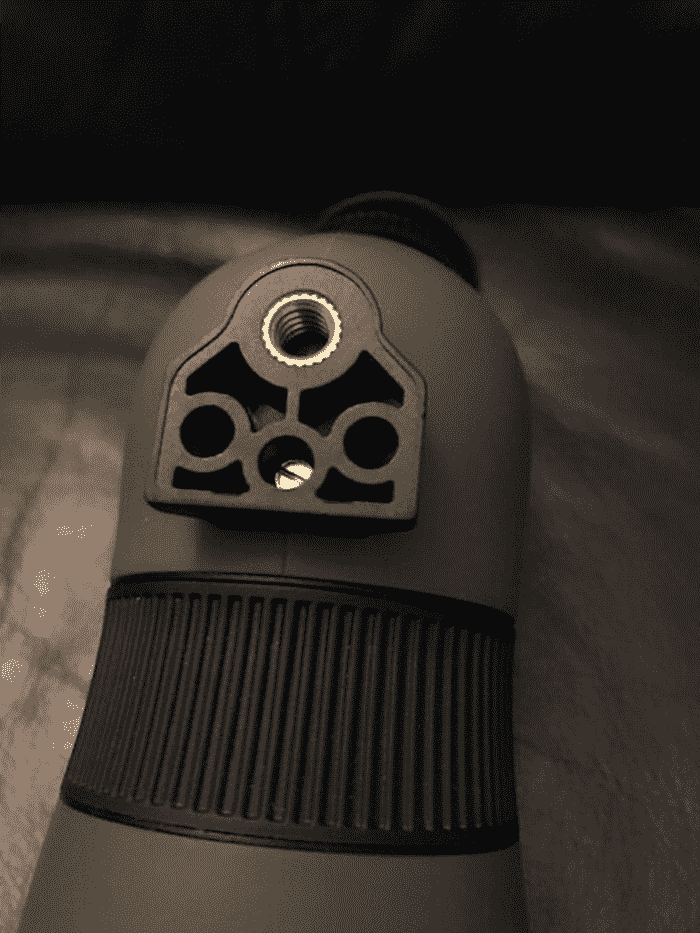
The underside of the mini spotter has a socket to attach it to either a monopod or tripod.
Overall, I was very impressed with the build quality on this nifty little spotting scope from Svbony; so small it fits snugly in the palm of your hand.
I keep the tripod mounting bracket on the underside of the scope for quick release from a tripod or monopod.
Optical Evaluation
My first test looked for stray light and internal reflections when pointed at an extremely bright light source. So on went my iPhone torch set to its brightest setting. After focusing the beam from across a living room, I was able to establish that the unit displayed excellent suppression of internal reflections, but also very little in the way of diffused light and no diffraction spikes. Just like their SV 202 binoculars, this spotting scope was up there with them in terms of controlling bright light sources. I confirmed this after dark by looking at a bright sodium street lamp. All was well, as I expected, with a nice clean image of the lamp with no annoying internal reflections or diffraction spikes. Once again, good job Svbony!
Looking at the exit pupil as the scope was racked through its zoom magnification range showed a nice round light shaft throughout. The images below show the exit pupil at the 9x setting and the 27x setting for reference:
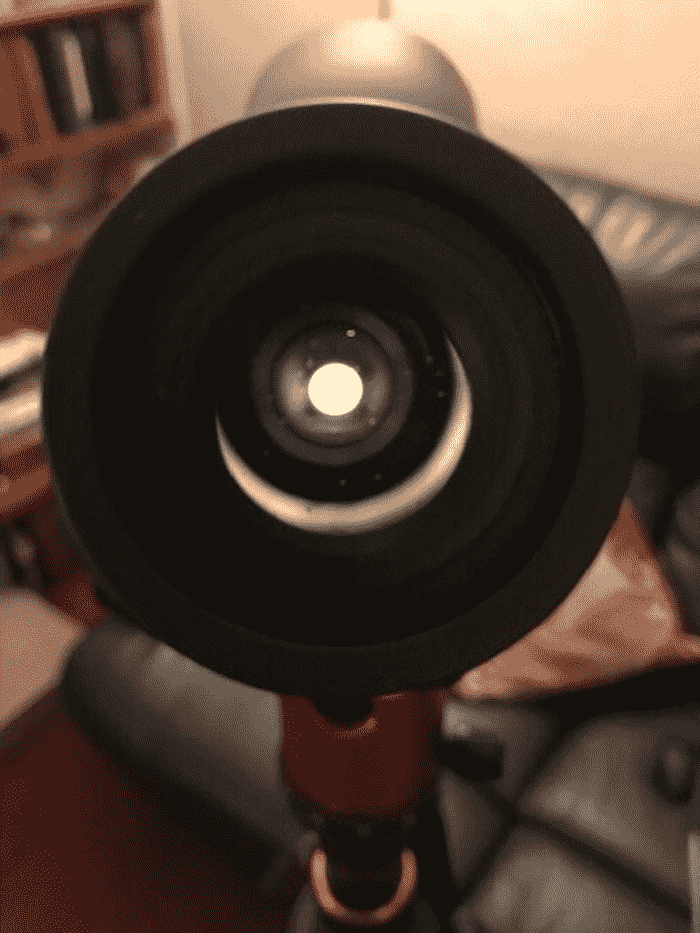
Exit pupil at 9x setting.
Exit pupil at 27x setting
Taking into consideration the extremely fast focal ratio of this Porro prism spotting scope ( f/3.4), requiring four objective lenses (one of which is an ED element) elements in three groups, I knew going in that the total elimination of chromatic aberration would be a tall order. But I was very pleasantly surprised when, after mounting the scope to a lightweight tripod, I racked it through its full range of magnifications, 9x through 27x, focused on a telephone pole set against a uniformly bright overcast sky. I noted that I could obtain a very sharp focus right up to 27x with only a modest amount of chromatic aberration seen around the edges of wires and the pole itself. Furthermore, any secondary spectrum seen was very sensitive to eye placement. I quickly learned to move my eye around to minimize it while observing my targets. In addition, moving off the axis shows some lateral chromatic aberration in this scope.
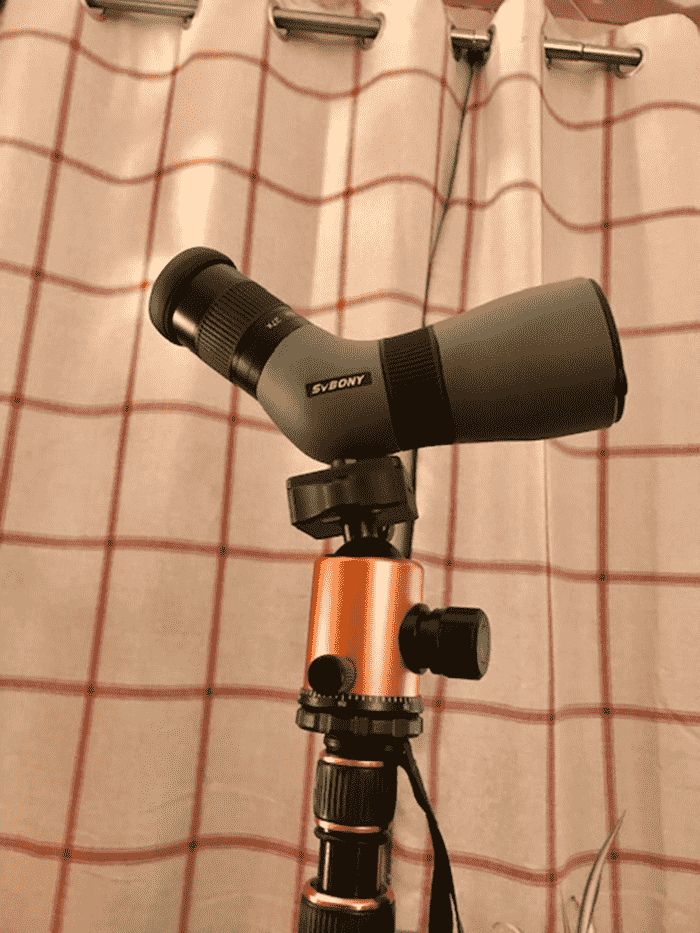
The Svbony SV 410 9-27 x 56mm ED spotter astride a lightweight tripod.
The image is bright and sharp, with excellent contrast. Autumn colors really showed up beautifully using this small spotting scope from the Far East. The eyepiece is not parfocal, however, thus requiring a significant amount of refocusing moving from low to high power The zoom is continuously variable however, from 9x through 27x
The image remained very sharp right out to the field stop, with only very minor field curvature and pincushion distortion; much less severe than the vast majority of binoculars I’ve tested over the last three years! I took the liberty of capturing some images through the Svbony mini spotting scope using my iPhone and a digiscoping adapter. The reader will bear in mind that these images were captured during the most adverse conditions possible with leaden rainclouds, windy gusts, and outbreaks of rain. All the images are entirely unprocessed and were taken directly from my iPhone.
First up, an image of some fence posts at just under 44 yards distant. The reader will note the magnification was set to 27x and shows extremely mild field curvature at the edges of the field.
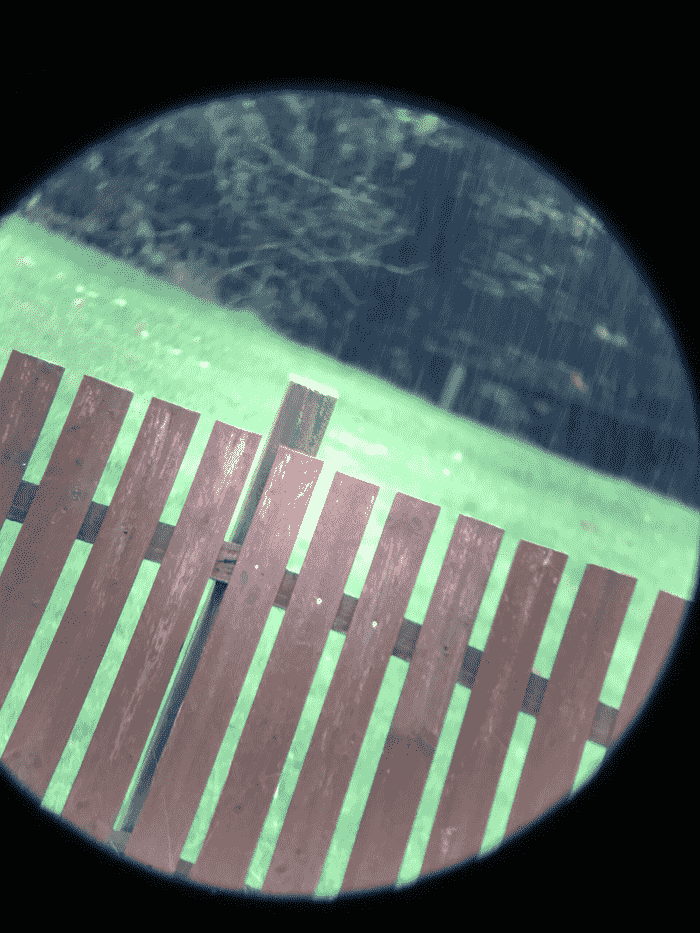
A wooden fence located at a distance of 43.8 yards, captured during very inclement lighting conditions.
The image below shows autumn leaves at 24 yards distance, power of 27x:
Autumn leaves at 27x, distance 24 yards.
The next image is also at 27x and shows a chimney and aerial at about 50 yards distant:

A chimney and aerial at 27x and 50 yards.
In my most severe test conducted, I took a shot of a telephone pole at a distance of 35 yards at 27x, showing some secondary spectrum. The reader will note that the amount seen by the naked eye is much less than the iPhone 7 captures:
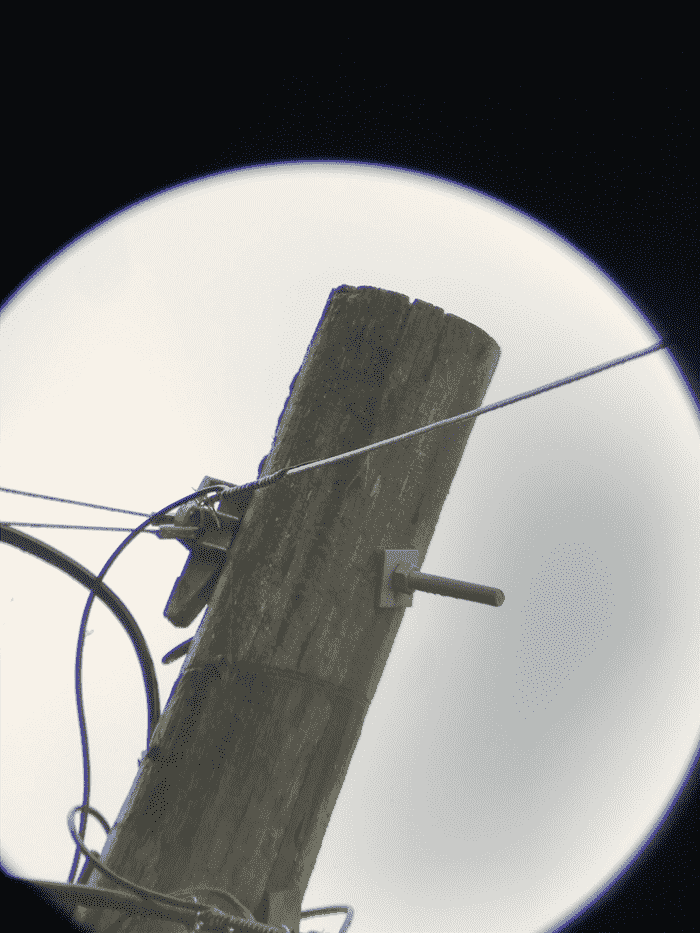
A telephone pole and wiring set against a grey, overcast sky. 35 yards distant, 27x.
Finally, I took a picture of a BlueTit at the bird feeder in my back garden: 15 yards distance, 27x:
A solitary Blue Tit gorging on some nuts at my birdfeeder: 15 yards, power 27x.
Further Notes from the Field
I measured the close focus on the Svbony SV 410 mini spotting scope to be 2.16m or 7 feet, just a little longer than the advertised 2m. That’s an excellent result, closer, in fact than a raft of other spotting scopes I’ve looked at. The nearest I got was 2.5m for the Opticron MM4 50 ED, and even the closest product to the Svbony – the Celestron Hummingbird 9-27 x 56 ED – has a close focus of nearly 10 feet! That’s great news for those who would like to use their spotting scopes as a long-range microscope. It’s quite amazing to be able to look at flowers, fungi, rocks, insects, and a host of other things at very close range at powers up to 27x. That, in my opinion, greatly increases its versatility.
Because it’s so small, the little Svbony spotter can be carried in a wide jacket pocket or a rucksack. Stable handholding is eminently possible at a power of 9x, but at higher powers, it does benefit from some sort of makeshift support such as a beanbag. I was able to stabilize the image completely by resting the spotter on the branch of a tree while viewing a pair of Mute Swans at one of my local patches when I could exploit the entire magnification range of the instrument.
For more hassle-free results, it pays to mount the spotter on a monopod, and because these are very lightweight and fold up to very convenient sizes, they can be carried about in a rucksack, with no hassle to the rambler.
The little Svbony Spotter mates effortlessly with a lightweight, collapsible monopod.
This would be a good place to compare and contrast some of the specifications of this Svbony mini ED spotting scope to an outwardly similar instrument – the Celestron Hummingbird 9-27 x 56mm ED. As well as having a significantly closer focus than the Hummingbird, it also sports a wider field of view. The Svbony has a field of view range from 2.1 to 4.5 angular degrees, as compared with the Hummingbird at 1.9 to 4.2 degrees. This makes object acquisition that little bit easier with the Svbony The eye relief is also better on the Svbony mini spotter (18mm as opposed to 15mm). Furthermore, the Svbony is about 30g lighter than the Celestron scope. But perhaps the best news of all is that the Celestron Hummingbird ED mini spotter retails for about £299.99. That’s a 66 percent markup in price compared with the Svbony! Is the Hummingbird really any better? I have my doubts!
Notes Gleaned from Looking at the Night Sky
Reviewers who only carry out terrestrial observations during daylight hours are prone to miss some important details about their subject instruments. As a case in point, I use my right eye for astronomical viewing through all my telescopes, and this little Svbony was no exception. At 9x I noticed mild astigmatism in my own eye was showing up in images of bright stars in the spotting scope’s field of view. But when I cranked up the power to 27x, the astigmatism was noticeably less. Viewing with my glasses on effectively eliminated this astigmatism. Had I confined my viewing to daytime targets, I would be none the wiser to this aberration originating from my own eyes.
Star images remained nice and tight nearly all the way to the field stop at all magnifications, just as the photos above reveal. The instrument clearly has a very flat and well-corrected field.
The Svbony SV 410 mini ED spotting scope proved to be an excellent instrument for observing the Moon, which I enjoyed doing over a couple of weeks in October. There are no annoying reflections and diffraction spikes in the images it served up. A great amount of detail was gleaned at 27x; craters, maria, valleys, and mountains all showed up with beautiful sharpness and contrast. I detected some slight fringing at the lunar limb, but this was also sensitive to eye placement. In comparison to my 20 x 60 Pentax PCF binocular, the Svbony showed slightly less color fringing on the Moon but was its equal for sharpness and contrast – a very good result indeed, as I rate the latter very highly as a Moon-gazing binocular.
Bright stars like Vega reveal a trace of the secondary spectrum at the highest powers as does the bright planet Jupiter, but I was just able to make out two bands straddling the planet’s equator and the four large Galilean satellites were very clearly discerned as tiny stellar-like point sources. I was also delighted to see Saturn’s majestic rings with the little Svbony spotter, and even its largest satellite, Titan.
In the late evening of October 30, I enjoyed a long clear spell with the waning Moon out of the sky. Mounting the spotter on my tripod, I examined a suite of double stars to test the resolving capabilities of this pint-sized scope. My first target was Mizar & Alcor low in the northern sky, where I was able to prize apart the tight companion to Mizar at 27x. Albireo( Beta Cygni) was beautiful and easy at powers above 12x, but most compelling at 27x. The view of the celebrated binocular multiple star system Omicron^1 Cygni was gorgeously presented at 27x, the wonderful color contrast of its components coming through clearly. The components of Beta Lyrae were also cleanly resolved, and an especially lovely sight at 27x. Perhaps my most challenging split came when I turned the instrument on the orange star Gamma Delphini, now sinking into the west south-westerly sky. Taking that little bit extra care focusing on this system at 27x revealed the prize I had been looking for; its fifth magnitude companion being just resolved with a steady gaze. This will make an excellent instrument for observing traditional binocular doubles, allowing you to study them at significantly higher powers than regular binoculars!
The main body of the Pleiades was nicely framed in the 2.1-degree true field of the Svbony SV 410 ED spotting scope at 27x. Many dozens of stars filled the field from edge to edge, including many double and multiple star systems easily discerned at the highest powers available to me. What appeared very odd to me at first, was the orientation of the stars making up this most celebrated herald of autumn. Of course, it presents the view as the eye sees it(only magnified), but being very accustomed to viewing stars through Newtonians and (in a former life), small refractors yielding upright but mirror-reversed images, it took a bit of getting used to in this quirky little spotting scope. Pointing the scope much higher up in the night sky showed me a very nice view of the great Galaxy in Andromeda(M31), together with its fainter companions M32 near the core, and M110 about a degree off to the northwest of the core of M31. The Double Cluster in Perseus, now near the zenith, stood out beautifully at 23x against a jet black hinterland. The Coathanger asterism in Vulpecula was an awesome sight at powers between 15x and 23x. And while sinking quite low into the north-western sky, I enjoyed some very fine views of M13 and M92 in Hercules.
As local midnight approached, I began observing the trio of Messier open clusters in Auriga. At 27x, one can begin to resolve these celebrated clusters into dozens of individual stars. Later on again, in the wee small hours of Sunday morning, October 31, I went in search of M35, that wonderful, sprawling open cluster in the northern foot of Gemini, and was rewarded by a very compelling sight at powers above 20x, when several dozen of its brightest luminaries began to be resolved in the spotting scope. That weekend night vigil convinced me that a great deal of astronomy can be done with such a tiny scope as this. It’s very easy to find objects at 9x before zooming in for a closer look.
Conclusions & Recommendations
My experiences with the Svbony SV 410 9-27 x 56 ED spotting scope have been very pleasing indeed. Its low cost, solid optical performance, ease of handling, outdoor ruggedness, and very lightweight will appeal to a great many individuals wanting to make a move into the high magnification world of sport optics. And while not a full-sized instrument with its larger aperture and magnification range, this pint-sized scope will fill a niche for many, serving multiple purposes as a rich field travel and spotting telescope, as well as a high-powered long-range microscope that you can take with you anywhere.
Highly recommended!
Here's the original post: Product Review: Svbony SV410 9-27 x 56mm ED Mini Spotting Scope.








